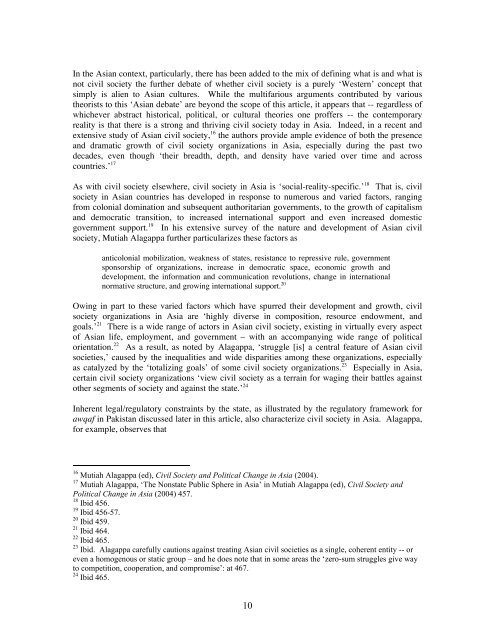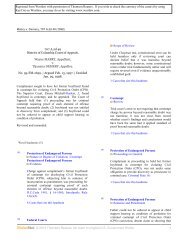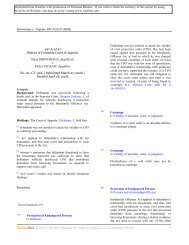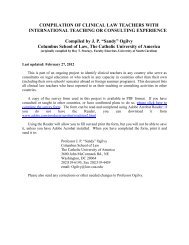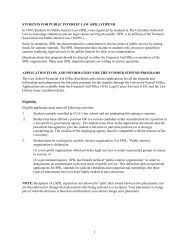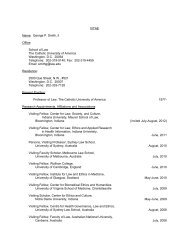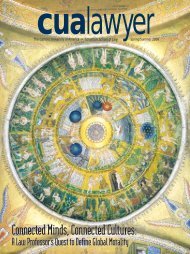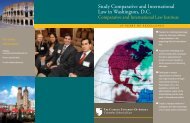In the Asian context, particularly, there has been added to the mix <strong>of</strong> defining what is and what isnot civil society the further debate <strong>of</strong> whether civil society is a purely ‘Western’ concept thatsimply is alien to Asian cultures. While the multifarious arguments contributed by varioustheorists to this ‘Asian debate’ are beyond the scope <strong>of</strong> this article, it appears that -- regardless <strong>of</strong>whichever abstract historical, political, or cultural theories one pr<strong>of</strong>fers -- the contemporaryreality is that there is a strong and thriving civil society today in Asia. Indeed, in a recent andextensive study <strong>of</strong> Asian civil society, 16 the authors provide ample evidence <strong>of</strong> both the presenceand dramatic growth <strong>of</strong> civil society organizations in Asia, especially during the past twodecades, even though ‘their breadth, depth, and density have varied over time and acrosscountries.’ 17As with civil society elsewhere, civil society in Asia is ‘social-reality-specific.’ 18 That is, civilsociety in Asian countries has developed in response to numerous and varied factors, rangingfrom colonial domination and subsequent authoritarian governments, to the growth <strong>of</strong> capitalismand democratic transition, to increased international support and even increased domesticgovernment support. 19 In his extensive survey <strong>of</strong> the nature and development <strong>of</strong> Asian civilsociety, Mutiah Alagappa further particularizes these factors asanticolonial mobilization, weakness <strong>of</strong> states, resistance to repressive rule, governmentsponsorship <strong>of</strong> organizations, increase in democratic space, economic growth anddevelopment, the information and communication revolutions, change in internationalnormative structure, and growing international support. 20Owing in part to these varied factors which have spurred their development and growth, civilsociety organizations in Asia are ‘highly diverse in composition, resource endowment, andgoals.’ 21 There is a wide range <strong>of</strong> actors in Asian civil society, existing in virtually every aspect<strong>of</strong> Asian life, employment, and government – with an accompanying wide range <strong>of</strong> politicalorientation. 22 As a result, as noted by Alagappa, ‘struggle [is] a central feature <strong>of</strong> Asian civilsocieties,’ caused by the inequalities and wide disparities among these organizations, especiallyas catalyzed by the ‘totalizing goals’ <strong>of</strong> some civil society organizations. 23 Especially in Asia,certain civil society organizations ‘view civil society as a terrain for waging their battles againstother segments <strong>of</strong> society and against the state.’ 24Inherent legal/regulatory constraints by the state, as illustrated by the regulatory framework forawqaf in Pakistan discussed later in this article, also characterize civil society in Asia. Alagappa,for example, observes that16 Mutiah Alagappa (ed), Civil Society and Political Change in Asia (2004).17 Mutiah Alagappa, ‘The Nonstate Public Sphere in Asia’ in Mutiah Alagappa (ed), Civil Society andPolitical Change in Asia (2004) 457.18 Ibid 456.19 Ibid 456-57.20 Ibid 459.21 Ibid 464.22 Ibid 465.23 Ibid. Alagappa carefully cautions against treating Asian civil societies as a single, coherent entity -- oreven a homogenous or static group – and he does note that in some areas the ‘zero-sum struggles give wayto competition, cooperation, and compromise’: at 467.24 Ibid 465.10
[a]lthough civil society organizations have become more numerous and consequential inpolitics … the institutionalism <strong>of</strong> the realm <strong>of</strong> civil society as a legally protected spacefor autonomous organization and site for critical reflection, discourse, and governancethat is independent <strong>of</strong> the state has made comparatively less headway in Asiancountries. 25Many Asian countries do provide constitutional guarantees <strong>of</strong> the right to free association andpolitical expression. Further, in many Asian countries, the legal frameworks do expressly supportthe formation and activity <strong>of</strong> civil society organizations. Factors such as political expediency bygovernments, inadequacy and corruption in the legal system, and such nebulous (and self-serving)concepts as ‘security interests’ and ‘public order,’ however, do severely constrain the activities <strong>of</strong>civil society organizations in Asia. In South Asia, for instance, governments have taken a‘dominant interventionist role … [taking upon themselves] a pre-eminent and monopolisticstance’ in defining these and other related concepts. 26In some Asian countries, such as Pakistan, these factors are even more exacerbated by ‘anambiguous [legal and regulatory] framework that is made worse by the high discretion accordedgovernment <strong>of</strong>ficials and their arbitrary application <strong>of</strong> laws.’ 27 Consequently, while civil societyorganizations in Asia are numerous -- Pakistan, for example, <strong>of</strong>ficially listed about 45,000 active,non-pr<strong>of</strong>it organizations operating in 2002 28 -- many prefer to be <strong>of</strong>f the bureaucratic radar <strong>of</strong> thegovernment. Alagappa estimates that, especially in authoritarian and communist countries, thenumbers <strong>of</strong> civil society organizations may be dramatically higher: many civil societyorganizations avoid registration with the government or otherwise circumvent governmentregulations by registering as businesses or companies. 29<strong>II</strong>I.ISLAM AS A STRONG FORCE FOR BUILDING C<strong>IV</strong>IL SOCIETYIt is against the backdrop <strong>of</strong> struggle and government constraints to the development <strong>of</strong> civilsociety in Asia that Islamic institutions, such as awqaf, could be influential. Especially in SouthAsia, religion and religious practices play a crucial role in the development <strong>of</strong> nonpr<strong>of</strong>it legalsystems. 30 Indeed, recent scholarship in the field has refocused extensive attention on thereligious roots and the influences <strong>of</strong> religion on the nonpr<strong>of</strong>it world in South Asia. 31 And inIslamic countries such as Pakistan, <strong>of</strong> course, Islam is a powerful socio-political force.Interestingly, scholars in the field <strong>of</strong> civil society also have found themselves at odds over theissue <strong>of</strong> whether Islam is compatible with or in opposition to civil society. 32 While such25 Ibid 470.26 Rajesh Tandon, Voluntary Action, Civil Society and the State (2002) 70.27 Alagappa, above n 17, 474.28 Ibid 457.29 Ibid 458. As explained by Barnett Baron in his Opening Remarks for a Workshop Held at the CatholicUniversity <strong>of</strong> America, <strong>April</strong> 12, 2002, ‘nonpr<strong>of</strong>it organizations throughout the [Asian] region are generallymore heavily regulated than commercial firms.’ Barnett F. Baron, ‘The Legal Framework for Civil Societyin East and Southeast Asia’ (2002) 4(4) The International Journal <strong>of</strong> Not-for-Pr<strong>of</strong>it <strong>Law</strong>, 7 at 19 July 2005.30 Mark Sidel and Iftekhar Zaman, ‘Philanthropy and <strong>Law</strong> in South Asia: Key Themes and Key Choices’ inMark Sidel and Iftekhar Zaman (eds), Philanthropy and <strong>Law</strong> in South Asia (2004) 15, 19-20.31 Ibid 20.32 This debate, <strong>of</strong> course, is premised upon a somewhat narrow definition <strong>of</strong> civil society, and fails to takeinto account the broader definition which literally includes all non-state associational life, such as Islamicand other religious associations.11
- Page 1 and 2: INTERNATIONAL JOURNAL OF CIVIL SOCI
- Page 3 and 4: Letter from the EditorDear Readers,
- Page 5 and 6: TABLE OF CONTENTSIJCSL EDITORIAL BO
- Page 7 and 8: ARTICLESTHE ROLE OF THE ISLAMIC WAQ
- Page 9: ‘a bewildering array of the good,
- Page 13 and 14: to integrate economic development a
- Page 15 and 16: duty.’ 55 In contrast to zakāt,
- Page 17 and 18: of such venerable educational insti
- Page 19 and 20: avoiding the appearance of impiety,
- Page 21 and 22: …’ 101 Throughout the Islamic w
- Page 23 and 24: partisan judiciary, a vigilant pres
- Page 25 and 26: number of awqaf for myriad public p
- Page 27 and 28: made over to the plundering hands o
- Page 29 and 30: prescribed by law. 159 Like the 192
- Page 31 and 32: property is not a waqf property or
- Page 33 and 34: VIII. REFERENCESA. Articles/BooksAh
- Page 35 and 36: Meidinger, Errol E, ‘Environmenta
- Page 37 and 38: STUDENT ARTICLESINTERNATIONAL INSTR
- Page 39 and 40: interest for the Balkan, minorities
- Page 41 and 42: dimension is emphasized with Articl
- Page 43 and 44: The Copenhagen document deals with
- Page 45 and 46: Historically, the 1946 Constitution
- Page 47 and 48: service, or sometimes 239 special f
- Page 49 and 50: This position by the Greek governme
- Page 51 and 52: a member of the civil state, entitl
- Page 53 and 54: Civilization" with headquarters in
- Page 55 and 56: term "vinozhito"(rainbow) could pos
- Page 57 and 58: declare the party as unconstitution
- Page 59 and 60: The cases analyzed below, exemplify
- Page 61 and 62:
ECHR, and based upon this analysis,
- Page 63 and 64:
Jabuka in particular, recognized as
- Page 65 and 66:
the minority still face problems in
- Page 67 and 68:
BibliographyBooks:BLACK’S LAW DIC
- Page 69 and 70:
Vlassis Vlassidis, Veniamin Karakos
- Page 71 and 72:
THE DIFFERING TAX TREATMENT OF INVE
- Page 73 and 74:
…any person who, for compensation
- Page 75 and 76:
the assets under management. 437 Th
- Page 77 and 78:
As a preliminary matter, a taxpayer
- Page 79 and 80:
Commissioner further summarized the
- Page 81 and 82:
number of itemized returns. These t
- Page 83 and 84:
fiduciary duty implications applica
- Page 85 and 86:
operate as a fraud or deceit upon t
- Page 87 and 88:
Policy ConsiderationsIn light of th
- Page 89 and 90:
more advantageous to address altern
- Page 91 and 92:
STUDENT NOTESBUILDING CONSUMER CAPA
- Page 93 and 94:
CASE NOTESC A N A D I A N S U P R E
- Page 95 and 96:
minimum constitutional protection t
- Page 97 and 98:
objective of ensuring safety in sch
- Page 99 and 100:
Turning to its impact on courts and
- Page 101:
tribunals to ensure that an appropr


